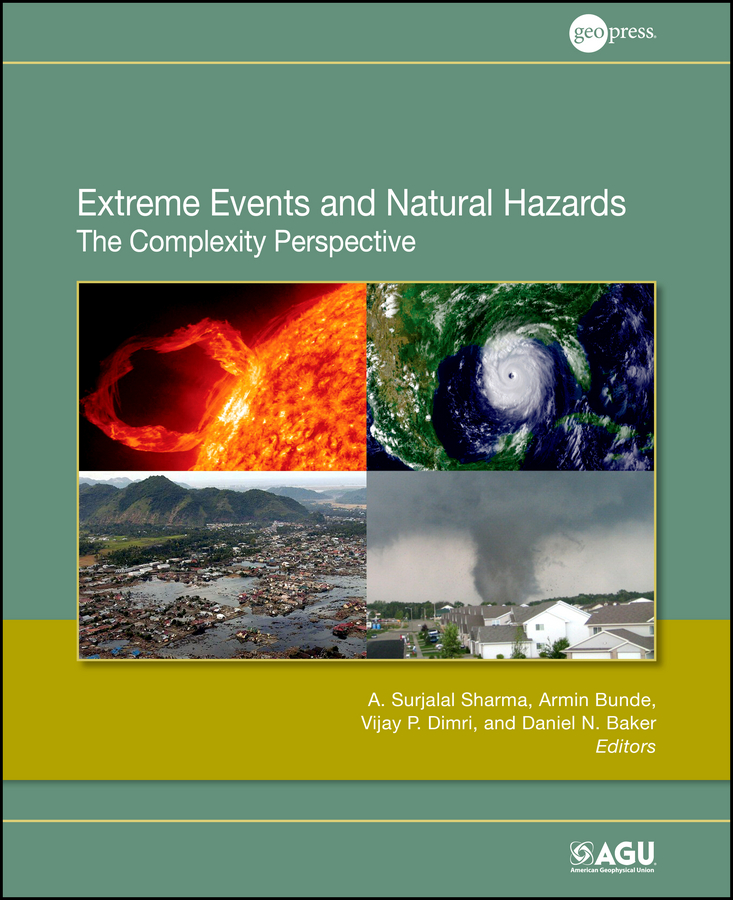Электронная книга: Armin Bunde «Extreme Events and Natural Hazards. The Complexity Perspective»

|
Published by the American Geophysical Union as part of the Geophysical Monograph Series, Volume 196. Extreme Events and Natural Hazards: The Complexity Perspective examines recent developments in complexity science that provide a new approach to understanding extreme events. This understanding is critical to the development of strategies for the prediction of natural hazards and mitigation of their adverse consequences. The volume is a comprehensive collection of current developments in the understanding of extreme events. The following critical areas are highlighted: understanding extreme events, natural hazard prediction and development of mitigation strategies, recent developments in complexity science, global change and how it relates to extreme events, and policy sciences and perspective. With its overarching theme, Extreme Events and Natural Hazards will be of interest and relevance to scientists interested in nonlinear geophysics, natural hazards, atmospheric science, hydrology, oceanography, tectonics, and space weather. Издательство: "John Wiley&Sons Limited"
ISBN: 9781118672235 электронная книга Купить за 9884.31 руб и скачать на Litres |
Armin Bunde
Armin Bunde (* 7. April 1947) ist ein deutscher theoretischer Physiker.
Bunde studierte Physik an der Universität Gießen und der Universität Stuttgart und promovierte 1974. 1982 habilitierte er sich an der Universität Konstanz und war dann als Heisenberg Stipendiat (von 1984 bis 1987) unter anderem in Boston und Tel Aviv. 1987 wurde er Professor an der Universität Hamburg. Seit 1993 ist er Professor an der Universität Gießen.
Bunde befasste sich mit Fraktalen, Perkolationstheorie, Polymerphysik, Zeitreihenanalyse, ungeordneten Systemen, Lokalisation, mesoskopischen Systemen und nanokristallinen Materialien, Quantenbillards und Ionengläsern. Dabei arbeitete er unter anderem eng mit Shlomo Havlin zusammen.
Mit Havlin und anderen analysierte er Temperaturschwankungen in der Atmosphäre und kritisierte damit 2002 gängige globale Klimamodelle, da sie das beobachtete Skalierungsverhalten (das ein Potenzgesetz und ein Beharrungsverhalten des Klimas zeigt[1]) nicht reproduzieren.[2] Er fand bei Untersuchung von Klimadaten Anzeichen für ein Persistenz-Verhalten in den Langzeitkorrelationen, beispielsweise in der Aufeinanderfolge extremer Ereignisse wie besonders hohe Nilhochwässer.[3]. Nachdem er zuvor eine skeptische Einstellung zu Vorhersagen der Erderwärmung hatte, änderte er 2006 seine Meinung.[4] Mit Sabine Lennartz gab er 2009 obere und untere Grenzwerte für den anthropogenen Anteil an der Erderwärmung[5].
Schriften
- mit Shlomo Havlin (Herausgeber): Fractals and Disorder. Springer, 1992, 2. Auflage 1996
- dieselben (Herausgeber): Fractals in Science. Springer, 1994, 2. Auflage 1995
- dieselben (Herausgeber): Percolation and Disordered Systems. Physica A, Bd.266, 1998, Nr. 1-4
- mit Eduardo Roman: Gesetzmäßigkeiten der Unordnung. Physik in unserer Zeit Bd.24, Heft 6, 2006 (Perkolationstheorie)
- mit Jürgen Kropp, Hans Joachim Schellnhuber (Hrsg.): The Science of disasters - climate disruptions, heart attacks and market crashes. Springer 2002 (darin Bunde, Havlin, Koscielny-Bunde, Schellnhuber Atmospheric Persistence Analysis: Novel approaches and applications, S.171, aus einer Konferenz Schloss Rauischholzhausen 1999)
- mit K. Funke, M. Ingram (Hrsg.): Structure and Dynamics of Ionic Glasses. North Holland 1998
Weblinks
Einzelnachweise
- ↑ Koscielny-Bunde, Bunde, Havlin, Roman, Goldreich , Schellnhuber: Indication of a Universal Persistence Law Governing Atmospheric Variability Physical Review Letters, Bd. 81, 1998, S.729, Eichner, Koscielny-Bunde, Bunde, Havlin, Schellnhuber: Power-law persistence and trends in the atmosphere: A detailed study of long temperature records, Physical Review E 68, 046133 (2003)
- ↑ Govindan, Bunde, Havlin Volatility in atmospheric temperature variability, Preprint 2002, Physica A , Bd.318, 2003, S.529, sowie Havlin, Bunde, Schellnhuber, Govinda, Vyushin, Brenner Global climate models violate scaling of the observed atmospheric volatility, Preprint 2002, Physical Review Letters Bd. 89, 2002, S.028501, Bericht dazu 2002.
- ↑ Bunde, Jan Eichner, Jan W. Kantelhardt, Havlin: Long-term memory: A natural mechanism for the clustering of extreme events and anomalous residual times in climate records, Phys. Rev. Lett., Bd. 94, 2005, Seite 048701. Bericht dazu 2005
- ↑ Focus Wissen, Odenwald Auf die Klimaskeptiker ist Verlass, 25. August 2006, Focus Online
- ↑ Sabine Lennartz, Armin Bunde: Trend evaluation in records with long-term memory: Application to global warming, Geophysical Research Letters, Bd.36, 2009, 36, L16706, Abstract, Bericht dazu 2010
Источник: Armin Bunde
Другие книги схожей тематики:
| Автор | Книга | Описание | Год | Цена | Тип книги |
|---|---|---|---|---|---|
| Armin Bunde | Extreme Events and Natural Hazards. The Complexity Perspective | Published by the American Geophysical Union as part of the Geophysical Monograph Series, Volume 196. Extreme Events and Natural Hazards: The Complexity Perspective examines recent developments in… — John Wiley&Sons Limited, электронная книга Подробнее... | 9884.31 | электронная книга |
См. также в других словарях:
Business and Industry Review — ▪ 1999 Introduction Overview Annual Average Rates of Growth of Manufacturing Output, 1980 97, Table Pattern of Output, 1994 97, Table Index Numbers of Production, Employment, and Productivity in Manufacturing Industries, Table (For Annual… … Universalium
Health and Disease — ▪ 2009 Introduction Food and Drug Safety. In 2008 the contamination of infant formula and related dairy products with melamine in China led to widespread health problems in children, including urinary problems and possible renal tube… … Universalium
Europe, history of — Introduction history of European peoples and cultures from prehistoric times to the present. Europe is a more ambiguous term than most geographic expressions. Its etymology is doubtful, as is the physical extent of the area it designates.… … Universalium
Earth Sciences — ▪ 2009 Introduction Geology and Geochemistry The theme of the 33rd International Geological Congress, which was held in Norway in August 2008, was “Earth System Science: Foundation for Sustainable Development.” It was attended by nearly… … Universalium
United States — a republic in the N Western Hemisphere comprising 48 conterminous states, the District of Columbia, and Alaska in North America, and Hawaii in the N Pacific. 267,954,767; conterminous United States, 3,022,387 sq. mi. (7,827,982 sq. km); with… … Universalium
china — /chuy neuh/, n. 1. a translucent ceramic material, biscuit fired at a high temperature, its glaze fired at a low temperature. 2. any porcelain ware. 3. plates, cups, saucers, etc., collectively. 4. figurines made of porcelain or ceramic material … Universalium
